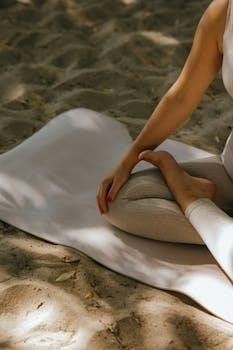quadratus lumborum stretch pdf

Quadratus Lumborum (QL) Muscle⁚ An Overview
The Quadratus Lumborum, or QL, is a deep abdominal muscle often overlooked as a source of low back pain. It’s crucial for side bending and extending the lumbar spine, contributing to movement and stability. Strong, flexible QL muscles promote ease of motion.
Anatomical Location and Function of QL
The Quadratus Lumborum (QL) is situated in the posterior abdominal wall, connecting the iliac crest to the lumbar vertebrae and the lowest rib. This anatomical positioning allows the QL to perform several crucial functions. Primarily, it aids in lateral flexion of the spine, assisting in side bending movements. Additionally, it contributes to spinal extension and stabilization. The QL also plays a role in pelvic stabilization and can assist with respiration by fixing the rib cage during forced exhalation; Proper QL function is essential for maintaining balance and supporting the lower back.
Causes and Symptoms of QL Pain
Sharp low back pain, possibly after exercise or deep breaths, can indicate Quadratus Lumborum issues. Tight QL muscles can cause uneven hips or anterior pelvic tilt. Addressing QL pain involves understanding its causes.
Common Causes of QL Pain
Quadratus Lumborum (QL) pain can stem from various factors, including tension and trigger points within the muscle itself, particularly in cases of chronic low back pain. Activities like cycling or even taking a deep breath can sometimes trigger QL pain. Weak or tight QL muscles also contribute, potentially leading to imbalances such as uneven hips or anterior pelvic tilt. Therefore, recognizing these common causes is the first step in managing and alleviating QL-related discomfort.
Symptoms Associated with QL Pain
Symptoms of Quadratus Lumborum (QL) pain can manifest as a sharp pain in the low back, particularly after activities like cycling or deep breathing following exercise. Individuals may experience a nagging, dull ache on the side of the spine, in the flank region. Tight QL muscles can also contribute to uneven hips, anterior pelvic tilt, and hyperlordosis. Recognizing these symptoms is crucial for identifying QL involvement in lower back discomfort.

Benefits of Stretching the QL Muscle
Stretching the Quadratus Lumborum (QL) provides significant benefits. It helps stabilize the spine, improves mobility, and reduces muscle tightness. Regular stretching alleviates nagging low back pain, promoting overall comfort and improved physical function.
Improved Spinal Stability and Mobility
The Quadratus Lumborum (QL) muscle plays a vital role in spinal stability. Stretching this muscle helps release tension, allowing for a greater range of motion in the lumbar spine. Improved mobility makes everyday movements easier, reducing the risk of injury. Flexible QL muscles contribute to a more balanced posture, preventing uneven hips and anterior pelvic tilt. This enhances overall physical performance and reduces discomfort during activities. Regular QL stretches are essential for maintaining a healthy and functional spine. This benefit increases strength and mobility;
Pain Relief and Reduced Muscle Tightness
Stretching the Quadratus Lumborum (QL) muscle can provide significant pain relief in the lower back. Tight QL muscles are often a primary cause of discomfort and stiffness. Regular stretching helps release trigger points, reducing tension and sensitivity in the muscle. This leads to improved flexibility and a decreased sensation of tightness. Pain reduction allows for better posture and more comfortable movement throughout the day. Stretching promotes blood flow, aiding in muscle recovery and reducing inflammation. This makes QL stretches a valuable tool for managing chronic low back pain and promoting overall well-being.

Effective QL Stretches
Several stretches effectively target the Quadratus Lumborum (QL) muscle, alleviating tightness and pain. These stretches include the banana stretch, child’s pose with lateral flexion, and standing QL stretch with a doorway. Regular practice can improve flexibility.
Banana Stretch
The banana stretch is an effective way to target the Quadratus Lumborum (QL) muscle for increased flexibility and pain relief. To perform this stretch, stand with your feet shoulder-width apart. Raise one arm overhead and gently lean to the opposite side, forming a “banana” shape with your body. Hold the stretch for 20-30 seconds, breathing deeply. Be cautious not to overextend, and stop if you feel any sharp pain. This stretch helps to lengthen the QL muscle, reducing tension and improving spinal mobility. Remember to stretch both sides equally for balanced relief.
Child’s Pose with Lateral Flexion
Child’s pose with lateral flexion is a static stretch that effectively targets the Quadratus Lumborum (QL) muscle. Begin in a traditional child’s pose, kneeling with your knees wide apart and your forehead resting on the floor. Extend your arms forward. Then, walk your hands to one side, feeling a stretch along the opposite side of your lower back. Hold the position for 20-30 seconds, breathing deeply to enhance the stretch. Repeat on the other side. This variation increases the stretch on the QL, promoting relaxation and reducing muscle tightness.
Standing Quadratus Lumborum Stretch with Doorway
The standing Quadratus Lumborum stretch with a doorway is an accessible way to target this muscle. Stand in a doorway, feet shoulder-width apart. Raise one arm overhead and gently lean towards the opposite side, using the doorway for support if needed. You should feel a stretch along the side of your lower back. Hold for 20-30 seconds, breathing deeply. Repeat on the other side. This stretch helps to release tension and improve flexibility in the QL muscle, promoting better spinal health.

Other Treatment Options for QL Pain
Besides stretching, treatments like manual trigger point therapy can relieve QL pain. Dry needling offers instant relief by reducing muscle tension. TENS and ultrasound are modalities that also help reduce pain and muscle irritability in the lower back.
Manual Trigger Point Therapy
In cases of chronic low back pain, the quadratus lumborum often exhibits tension and trigger points. Manual trigger point therapy is an effective approach to address these issues, providing relief by directly targeting and releasing the trigger points within the muscle. This hands-on technique helps to alleviate pain, reduce muscle tension, and restore normal muscle function in the affected quadratus lumborum muscle, improving overall comfort and mobility for individuals experiencing lower back discomfort.
Dry Needling
Dry needling presents another treatment option for quadratus lumborum pain, offering immediate relief from trigger point pain. This technique reduces tension and sensitivity in the hyperactive muscle. By inserting thin needles into specific trigger points, dry needling aims to release muscle knots and alleviate pain. This approach can effectively reduce the irritability of the quadratus lumborum, contributing to improved comfort and function in the lower back. As a result, individuals may experience enhanced mobility and reduced discomfort.
TENS and Ultrasound
Transcutaneous Electrical Nerve Stimulation (TENS) and ultrasound serve as commonly used modalities for managing quadratus lumborum pain. These therapies contribute to pain reduction and decreased muscle irritability. TENS units deliver mild electrical impulses to the affected area, disrupting pain signals. Meanwhile, ultrasound therapy utilizes sound waves to generate heat, promoting tissue relaxation and reducing inflammation. Both TENS and ultrasound can effectively alleviate discomfort associated with QL pain, facilitating improved function and comfort.
Home Care and Prevention
Managing QL pain involves staying active with aerobic exercise to promote blood flow. Maintaining good posture is also crucial. Home treatment, combined with medical approaches, can effectively reduce discomfort and improve overall well-being, as well yoga stretches.
Staying Active with Aerobic Exercise
Engaging in regular aerobic exercise is an effective strategy for managing quadratus lumborum pain. Activities that promote blood flow, such as walking or running, can be particularly beneficial. It’s essential to listen to your body and choose activities that feel comfortable, avoiding movements that exacerbate pain. Upright exercises might be preferred over those that involve hunching over. Any type of aerobic exercise will help, says Dr. Matos. Let pain be your guide as to what activity you choose.
Maintaining Good Posture
Good posture plays a vital role in preventing and managing quadratus lumborum pain. Poor posture can contribute to muscle imbalances and strain the QL. Focus on maintaining a neutral spine and proper alignment throughout the day, whether sitting or standing. Be mindful of your posture during activities like lifting or prolonged sitting. Ergonomic adjustments to your workspace can also support better posture. Maintaining good posture will help relieve the pain and strain on the QL muscle, says Dr. Montgomery.

Role of Exercise Devices
Specific exercise devices can enhance QL stretching effectiveness. Devices such as the Pelvic Clock Exercise Device facilitate more targeted and efficient QL stretches. These tools promote spinal stability and help address imbalances related to QL tightness, and promote flexibility.
Pelvic Clock Exercise Device for QL Stretching
The Pelvic Clock Exercise Device is designed to improve the effectiveness of quadratus lumborum (QL) stretches. Tight QL muscles can lead to uneven hips and anterior pelvic tilt. This device helps target the QL muscle, promoting better spinal alignment. By facilitating controlled pelvic movements, it allows for more precise and efficient stretching. The device enhances mobility, reduces muscle tightness, and supports overall lower back health. Its design promotes optimal QL engagement, leading to improved flexibility and stability, while preventing hyperlordosis of the lumbar spine and twisted pelvis.
QL and Related Conditions
QL imbalances can contribute to various conditions, including low back pain and postural issues. Weakness may correlate with obesity, while asymmetries are often seen in sports. Addressing QL health is crucial for overall well-being and athletic performance.
QL Muscle Weakness and Obesity Correlation
The relationship between quadratus lumborum (QL) muscle weakness and obesity has been explored, with some studies suggesting a correlation. The lack of consistency in the relationship between cross sectional area and back function may be because of various factors. Maintaining a healthy weight and engaging in regular exercise can help strengthen the QL and improve overall back health. Further research is needed to fully understand this connection, but promoting overall fitness remains beneficial.
QL Asymmetries in Sports
Quadratus Lumborum (QL) asymmetries can occur in sports, particularly those involving repetitive unilateral movements. For example, studies have reported QL asymmetries in cricket fast bowlers on their dominant side. These asymmetries may contribute to imbalances and potential injury risks. Assessing and addressing QL imbalances through targeted stretching and strengthening exercises is crucial for athletes to maintain optimal performance and prevent pain. Elite Australian Football League players are another example of athletes susceptible to QL asymmetries.
Additional Resources
For further information on QL stretches, downloadable PDF guides are available. These resources offer valuable tips and exercises to help you effectively stretch and release the Quadratus Lumborum muscle, providing relief from pain and tightness.
Downloadable PDF Guides for QL Stretches
We’ve compiled valuable resources, including QL stretches and tips, into free, downloadable PDF guides. These guides offer a convenient way to access and utilize effective stretches for the quadratus lumborum muscle. They provide instructions and precautions to ensure safe and proper execution, helping you find relief from lower back pain. These downloadable resources are designed to support your journey towards improved spinal stability, mobility, and reduced muscle tightness, all from the comfort of your own home.